Great Streets and Human Enjoyment
My goodness but people certainly drive fast in the United States; it sure makes streets unpleasant. That was my first impression upon returning home from a recent trip to Paris and London, and I was only crossing 38th Street, hardly the biggest or fastest street around! Then, just this past week, two non-urbanists in my life had negative comments about street speed in Minneapolis. My mother indicated how she’s uncomfortable sitting at a sidewalk table along Lake Street in Uptown because of the proximity to and speed of passing traffic. A friend of mine who lives downtown is happy about all the development but really despises the wide one-way streets where speeds of 45 miles per hour is not uncommon.
So do it like Europe, right? This isn’t as clear-cut a case as you might think. Paris isn’t without wide streets and traffic that moves at a pretty good clip. Take the Avenue de Champs-Elysees, for example. I couldn’t help but notice that the cafes on that street are buffered by parked cars, a row of trees, a section of sidewalk, but in fact don’t even face the traffic. Wide boulevards allow enough space for human enjoyment to occur by more or less ignoring the passing traffic. In other words, people and moving traffic really don’t share the same space. In this context, Lake Street would be palatable if sidewalks were significantly wider and farther from all that fast traffic. It is notable that the recent car-free day in Paris was a wild success, and more notable that plans are being discussed to rebuild the Champs-Elysees with fewer traffic lanes.
Sidewalk tables on a narrower but still notably busy Paris street like Rue Soufflot face the street. They are buffered by a row of parked cars as well as street trees and a sidewalk that is perhaps 15 feet wide. For those at the café, this setback is more than enough, and the people watching far outweighs any negative aspects of traffic speed and noise. It is also important to note that passing traffic rarely exceeds 30 miles per hour, and much of it is around 20 (plenty!).
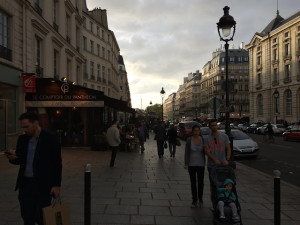
At Le Comptoir on Rue Soufflot in Paris, People-Watching is the Focus, and the Busy, Slow-Moving Street Fades in to the Background
Rue Tournefort provides an extreme example of the innate human pleasure only possible by slow-moving traffic. Here, café dwellers are less than five feet from the adjacent street, with no buffer, no trees, minimal bollards, and barely a curb. How is this possible? Easy. The street is only 18 feet wide, including a parking lane and contraflow bike lane! Posted speed limits are 30 kilometers per hour (about 18 miles per hour), and few vehicles reach this speed. Rue Tournefort is far from the only example I found.
When it comes to Minneapolis, Nicollet Mall is instructive in this discussion. Not everyone is happy that buses operate on the street, but the sidewalk seating at Brits Pub, for example, is an interesting case. The key isn’t that buses pass just feet from people sitting at tables, but their speeds are less than 20 miles per hour. Even if cars were allowed on Nicollet, its design speed is slow, allowing for significant human enjoyment. On Lake Street in Uptown it’s no wonder outdoor tables at restaurants like Barbette are located not facing Lake but along slow-moving Irving Avenue! A wide one-way street with three lanes of fast-moving traffic doesn’t equate to the human enjoyment of a meal.
In London, I couldn’t help but notice the relatively narrow streets, even the non-medieval alleyways, and proliferation of 20 mile-per-hour speed limit signs. Graham Road in Hackney, for example, is a basic busy street in London, a “High Street,” if you will. There is nothing special about this street in terms of landscaping or design; there is a street, a sidewalk, a few bollards and several storefronts. Graham Road succeeds at being comfortable for humans due primarily to low traffic speeds.
Of course, my favorite London example of “shared space” is the Seven Dials the West End. Seven slow-moving streets converge at this tiny roundabout, and pedestrians and cars more or less take turns. Traffic moves slowly enough that people not only feel comfortable crossing anywhere, but actually sitting under the dial in the middle of the intersection. I grabbed lunch from a nearby food truck and joined them. It was indeed very pleasant – excellent people watching! In one of his presentations, Ben Hamilton-Baillie shows a video of the beautiful dance of pedestrians and slow-moving traffic negotiating the Seven Dials, so I took a video of my own.
Chuck Marohn at Strongtowns points out that streets are typically designed by prioritizing speed and volume first, then cost, then safety, but if streets were designed for human enjoyment, they’d prioritize safety and cost before volume and speed. It is perhaps an oversimplification, but these examples in Paris and London (and even Minneapolis) provide glaring proof, in my opinion, that streets can actually be pleasant places when traffic speeds are 25 miles per hour or less. We need to seriously re-prioritize design speed if we really intend to improve safety and human enjoyment of our cities.
But lest I complain too much at this time. While it is imperative that we continue to improve our cities, given the attacks in Paris last week, the important thing right now is to experience what they have to offer. After all, no city is perfect. No matter the traffic speeds or street width, walk down the sidewalk and visit your favorite café or pub. Go to a show or game. Whether it is an act of defiance or simply a routine outing, sit at a sidewalk table and share a meal with a friend or family member. Go enjoy your city.
1 Comment »
RSS feed for comments on this post. TrackBack URI
Leave a comment
Line and paragraph breaks automatic, e-mail address never displayed, HTML allowed: <a href="" title=""> <abbr title=""> <acronym title=""> <b> <blockquote cite=""> <cite> <code> <del datetime=""> <em> <i> <q cite=""> <s> <strike> <strong>

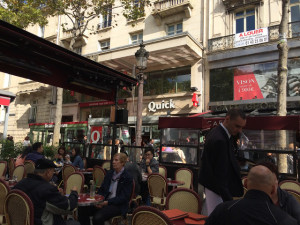
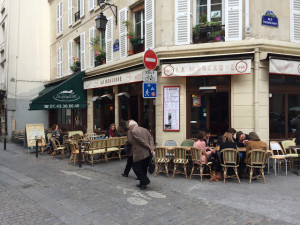
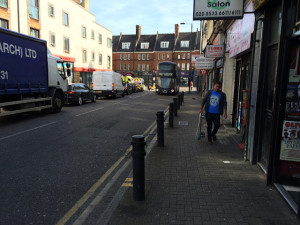
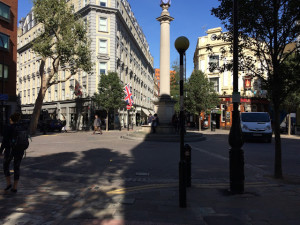
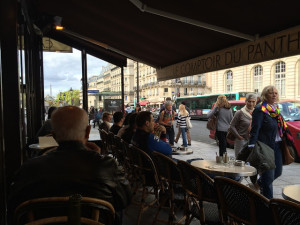
[…] how-to for good urban design, starting with the streets themselves. I previously wrote about busier streets in London (and Paris), but the smaller residential streets are the essential skeleton for good walkability. Most are […]
Pingback by Walking in Hackney | streets.mn — December 3, 2015 @ 5:00 pm